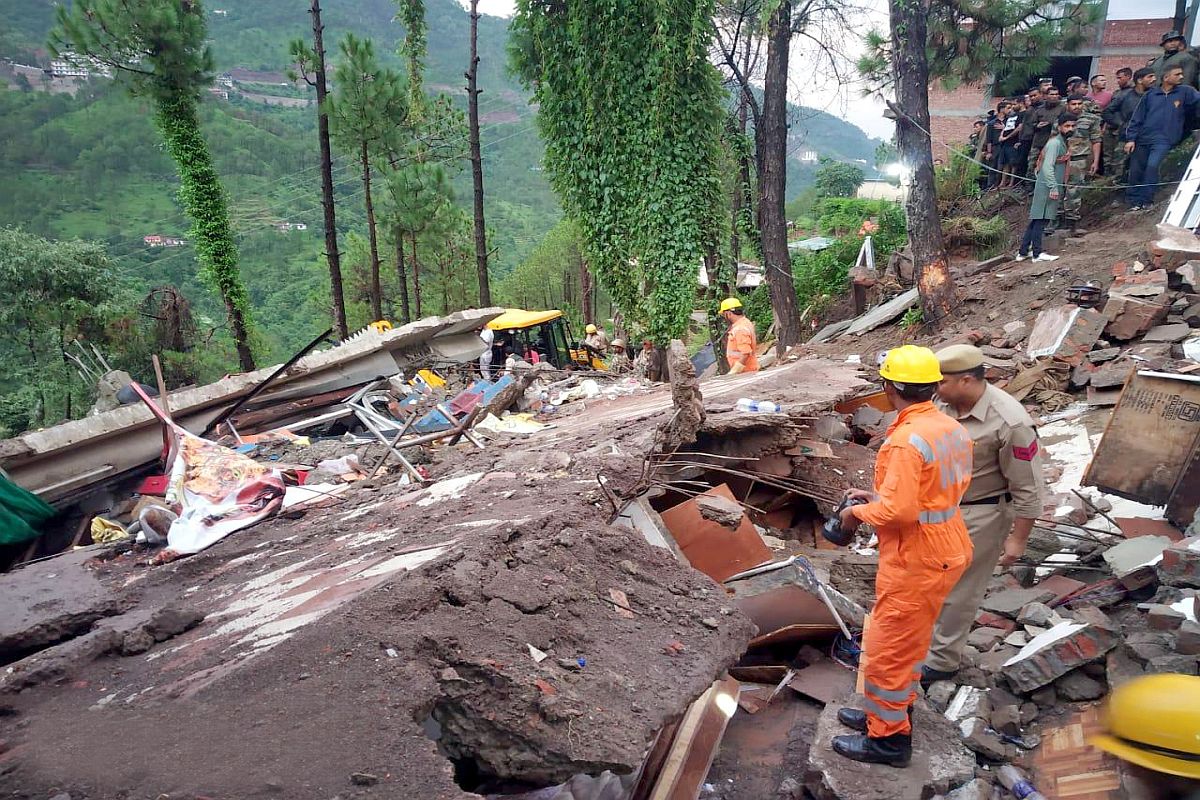The Himalayas are a holy land, dotted with sacred lakes, divine peaks and blue glaciers that gleam and soar in the collective imagination of the sub-continent” (Susan Jagannath). Sadly, much of the beauty of the Himalayas can now only be imagined. Countless road building projects, myriad tunnelling schemes and scores of hydro-power projects pock mark the mountains, and ubiquitously dug-up roads mar the beauty of the hills.
Additionally, scores of heavy trucks clog narrow hill roads, releasing unbearably toxic diesel fumes in the clean mountain air. Torrential rains, in July and August proved to be the last straw for the people of Himachal Pradesh and Uttarakhand. Frightening videos emerged, showing rows of houses disappearing in swirling rivers, landslides obliterating miles of highways and people trapped under tonnes of mud.
Many lost their loved ones, their houses, and their means of livelihood; roads, railways and other infrastructure projects, built at humongous cost, simply disappeared. Aid has been rushed to the affected people, ameliorating the catastrophe that had befallen them.
However, one fact stands out; despite increasing frequency of extremely heavy downpours, the present tragedy was accentuated by the lacklustre response of official machinery (Unwieldy Tides, 19 July 2023). Not India alone; the entire world is suffering due to extreme climate events: * Temperatures are rising worldwide, because increasing greenhouse gas emissions trap more heat in the atmosphere.
According to the World Metrological Organisation, the last eight years have been the hottest on record. After widespread heatwaves in 2022, April 2023 again saw heatwaves impacting all of Asia, including India and China. May and June were extremely hot, and according to Scientific American, July 2023, was the hottest month in the last 1,20,000 years, with heatwaves in Europe, North America, North Africa, China and Japan.
* Recognising that globally droughts are becoming longer and more extreme, the UN marked 17 June 2023 as ‘Desertification and Drought Day.’ * Tropical storms are becoming more severe due to higher ocean water temperatures. Eighty-eight storms occurred across the globe in 2022, of which, 40 reached tropical cyclone strength (=119 kmph), and 17 reached major tropical cyclone strength (=178 kmph). * Sea ice in the Arctic Ocean around the North Pole is melting faster with the warmer temperatures. * As temperatures rise, there is less snowpack, in mountain ranges and polar areas, and the snow melts faster. * Glaciers are melting at a faster rate.
According to a report from International Centre for Integrated Mountain Development, Kathmandu, glaciers in the Hindu Kush and Himalayan Mountain ranges melted 65 per cent faster between 2010 and 2019 than they did in the previous decade. The Ministry of Earth Sciences found that mean retreat rate of Hindu Kush Himalayan glaciers was 14.9-15.1 meters per year, 12.7- 13.2 meters per year in Indus, 15.5-14.4 meters per year in Ganga, and 20.2- 19.7 meters per year in Brahmaputra river basins.
The European Alps experienced a record amount of ice mass lost (State of the Climate in Europe, 2022). * Permafrost is melting, releasing methane, a powerful greenhouse gas, into the atmosphere. * Sea levels are rising at double the pace of 1993- 2002, threatening coastal communities and estuarine ecosystems. UN Climate Change Conferences (COP), have focussed on climate change.
Held recently, COP26 and COP27, were attended by almost 200 countries, represented by more than 100 Presidents/Prime Ministers. Each COP had more than 40,000 private participants, 14,000 observers and about 4,000 media representatives.
After weeks of pontification, most countries agreed to achieve climate control targets by 2050, while India proposed to do so by 2070. Consensus emerged to hold the increase in the global average temperature to well below 2°C above pre-industrial levels, preferably, to limit the increase to 1.5°C. Significantly, no timelines were prescribed. All participants were long on rhetoric but short on commitment ~ even in COP 27, which focused on implementation. Also, everyone looked to set goals, far in the future, when none of the attendees could be held responsible for their misleading promises.
Glaring anomalies were noticed; COP26 focussed on reducing dependence on fossil fuels but the main sponsors of the Conference, like that of COP 25, were fossil fuel and finance companies! PM Modi launched Mission LiFE (Lifestyle for Environment) with UN Secretary General Antonio Guterres in October 2022 ‘as a global initiative by India to help the world in its fight against climate change and lead to a sustainable way of life to achieve the Sustainable Development Goals.’ As pointed out in ‘Climate Change for Us’ (2 September 2022), insulation from the Asian landmass, by oceans in the south and the Himalayas in the north, protects us ~ though not totally ~ from depredations of our neighbours.
An honest effort to limit pollution and overexploitation of natural resources ~ the major causes of climate change ~ could yield immediate results. Thus, we have two alternatives; either go with the mainstream and make hollow promises with no intention of fulfilling them, or try and limit climate change for our country. The gains achieved by fighting against nature are transient; more than 1,200 roads in Himachal Pradesh, including some ‘all-weather’ roads, that were made by cutting mountains, are blocked due to landslides, erosion and damage.
Experts blame unscientific road construction, mainly cutting the mountains at extremely steep angles, for landslides. Construction debris dumped indiscriminately in rivers, has aggravated the floods, ravaging the benighted State. Mountains have been blasted for building tunnels and bridges; more than 37 bridges and 14 tunnels were made for the 197-kilometre Kiratpur-Manali Highway. Incidentally, this road could not be inaugurated, because a 16-kilometre stretch was washed away by floods in July 2023. Mutatis mutandis the same situation prevails in Uttarakhand.
Houses at various places, particularly Joshimath, developed huge cracks in December 2022, making them uninhabitable. Left homeless, townspeople suffered immensely in the harsh winter rain and snowfall. It would appear that draining of underground water by tunnelling activities had created a void below the earth’s surface, leading to the land giving way; ISRO reported land subsidence of 5.4 centimetres in just 12 days.
Still, NTPC and the Union Power Minister, denied any link between land subsidence and tunnel drilling for NTPC’s 520 MW Tapovan-Vishnugad hydel project. This callous approach is not exceptional; after the horrendous floods of 2013, that had caused more than 6,000 deaths, the then Uttarakhand Chief Minister refused to accept that faulty environmental policies had contributed to the tragedy. A shortsighted vision of development, through quick economic progress, by increasing manufacturing activity and tourism, have proved to be the bane of Himachal Pradesh and Uttarakhand.
The current spate of landslides and floods in Uttarakhand show that no lessons were learnt from the 2013 tragedy; the Railways are constructing the ambitious Char Dham Railway Project, a 125-kilometre railway line between Rishikesh and Karanprayag, with 105 kilometres of the rail line running through tunnels, including India’s longest railway tunnel of 15.1 kilometres.
Additionally, the large-scale road widening projects in both States, new resorts, houses and hotels built on and near riverbeds, all have precipitated the present disaster. Everyone pays lip service to environmental protection, for example, the 135th Report of the Parliamentary Standing Committee on Science and Technology, Environment Forest and Climate Change, tabled this month, took serious note of environmental destruction of the Himalayan ecosystem, but on a practical level, environmental concerns are always put on the backburner, sometimes, by creating a sham progress vs. environment debate.
The unstated Government policy is of not discouraging environmental transgressions, so much so, that if an environmental rule or law stands in the way of Ease of Doing Business, the law is often changed. Examples are numerous: Environment (Protection) Act, 1986; Forest (Conservation) Act, 1980; Wildlife Protection Act, 1972; Water (Prevention and Control of Pollution) Act, 1974; Air (Prevention and Control of Pollution) Act, 1981 and Indian Forest Act, 1927, were amended, as also the Environment Impact Notification and the Coastal Regulation Zone Notification.
Mankind can truly prosper, only by preserving the environment. As Michael Crichton wrote: “You think man can destroy the planet? What intoxicating vanity… Earth is four-and-a-halfbillion-years-old… In the thinking of the human being, a hundred years is a long time, but to the earth, a hundred years is nothing. A million years is nothing. We’ve been residents here for the blink of an eye. If we’re gone tomorrow, the earth will not miss us” (Jurassic Park).
(The writer is a retired Principal Chief Commissioner of Income-Tax)












